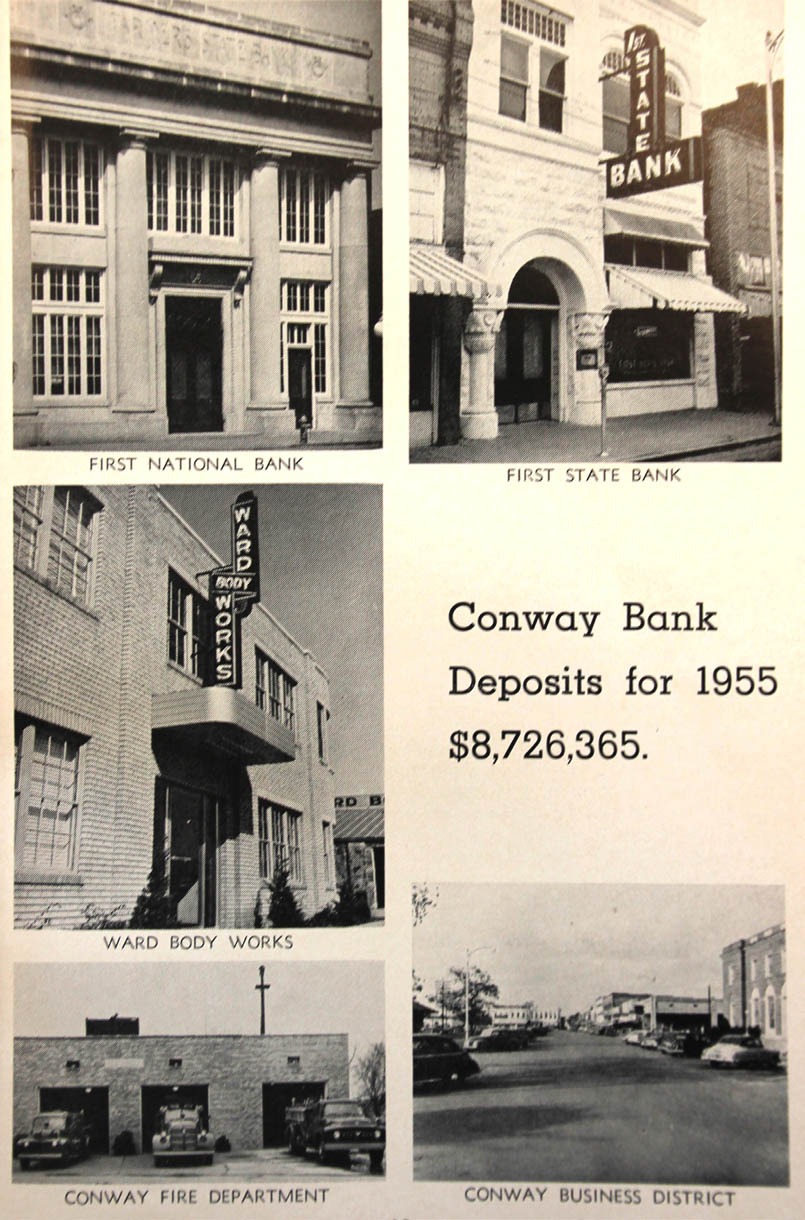14 May 2019 ‘Ounce for ounce, dollar for dollar’
by Vivian Lawson Hogue
During the 1950s, the adults in our town dealt with another war on the heels of World War II. Many of us also remember those years because of the heat and drought. Even the chickens were going feet up from the heat, and the hens were not interested in laying or even clucking. The flies sat on the lip of your water glass knowing you were too hot to swat with the old screen-wire flyswatter. The attic or window fans did an adequate job of cooling inside, but sometimes you just had to get out of the house and walk downtown, or uptown as the case might be.
Nothing since can compare to Old Conway in terms of the education one could receive through many products and types of stores. Every type of business imaginable provided one with items needed or wanted, whether utilitarian or frivolous. If the item was too luxurious, it could mean the 48-minute, two-lane highway drive to Little Rock.
Even the pages of a 1956 City Directory can send me back to age 13 when our population was 8,247. The Conway Chamber of Commerce boasted of great employment in small industries and factories and diversified agriculture. How completely that changed in only 40 years!

There was only one antique store, as most people were using the furniture and household items that would eventually become antiques. With added nearby businesses within the small city limits, there were 31 service stations, 10 barber shops, 22 cafes, 28 churches, nine department stores, 40 grocery stores, six jewelers, seven factories, 11 motels and two hotels. Add to that, four kindergartens, five public schools and three parochial schools and we were an exceptional town for our size. From all of these there was much to learn, whether on purpose or not, and it has been valuable.
Years ago I had a blog, and on one occasion I covered the subject of early shopping experiences. I learned many things downtown at the waist-high level of my mother, and it was mostly in grocery stores. I still apply the learned observations and know to stay alert for changes!
Canned vegetables were 16 ounces and are now between 13 and 15.75 ounces. The can size may still be the same, but there is more liquid and a higher price. When I shop, I actually shake a tuna can to find the one that sloshes the least. “Wild caught” better mean it was caught and processed in the U.S.
Peanut butter jars often have an indention in the bottom giving less product but appearing larger. Cereal boxes are now thinner, but not shorter, and contain much less product. “New and improved” may only mean a package redesign. Cereal varieties and brands are now in the hundreds, all with more sugars, dyes and preservatives.
Since we no longer have many outhouses needing Sears catalogues, I’ve paid more attention to toilet paper rolls and will not buy the one from the offensive TV commercials. Some brands that were once tightly rolled and firm are now mashable. They have less paper and are rolled loosely to appear fuller. The inner cardboard cylinders used to fit the dispenser rollers, but now are about one inch shorter, and the cylinder diameters are much larger, again for appearance.
Two readers had noticed that a gallon of ice cream is no longer a gallon, but only 3 1/2 quarts. One person asked, “Do you think the price dropped by 25 percent?” The answer was no, but it predictably cost more.
Several years ago, bacon became only 12 ounces instead of 16 ounces and double in price. Like everything else, it makes a difference in recipe needs, but this was not the manufacturer’s problem. You just needed to pay for another package to have enough.
My mother would always tell me to reach to the back of a shelf to get the newer stock and check the date, but to know it would not self-destruct on that date. If 50¢-a-gallon jugs of milk were reduced to 25¢, I should proudly grab one. I was not good at math, but I did learn that “50¢ apiece or 2 for a dollar” made no sense OR cents!
Her lesson about smelling the broken-off stem end of a cantaloupe, which indicates ripeness, worked until recently when they started twisting the stems off green, thus covering up the spot. Now you don’t know until you’ve paid for and sliced it that it is no good and will never ripen further.
Where we once trusted food manufacturers, distributors and local merchants, we’ve needed to become label readers and comparison shoppers. Here in what was Old Conway, our butchers knew us by name and asked how the family was doing. They sold fresh meat, and you could tell from their white aprons doused with blood. Saline injections or hormones were in the future.
I value my downtown education and wish I could say to my mother that I now know how she fed a large family while helping raise and educate all five children through a Depression and a few wars. To paraphrase Proverbs 31:29 for such women, “Many women do noble things, but you surpass them all.”
- My very own Mayberry - March 31, 2024
- The fine line between family and friends - March 10, 2024
- Seniors again - February 1, 2024











